War Memorial Hall c1929

Stanley Keith MUIR
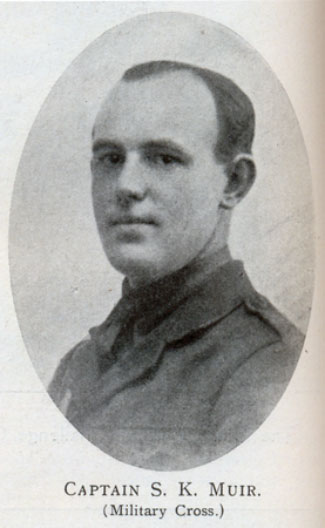
Stanley Muir was born on 6 April 1892 in Caulfield, Victoria. His parents were John Franklin and Josephina (née Holmes) Muir. He attended Scotch from 1899 to 1901.
Stanley was a station overseer when he enlisted on 18 August 1914 at Broadmeadows, Victoria. He served in No. 68 Squadron, Royal Flying Corps with the rank of Captain. His Regimental Number was 152 (while in the AIF).
Stanley died on 12 September 1917 at Harlaxton, England. He was 25 years of age.
Service record
He embarked from Melbourne as a Private in the 4th Light Horse Regiment on 19 October 1914. In Egypt he was hospitalised for nearly a month with ‘rheumatism’ in March and April. He joined the regiment as a reinforcement on Gallipoli on 27 July 1915. After being involved in the August offensive he was promoted to Corporal on 13 August 1915. He fell ill again on 31 August and was evacuated to Malta with a diagnosis of ‘rheumatism’. He was later transferred to London for further medical treatment, now with a diagnosis of ‘enteric fever (slight)’. Enteric fever is more commonly known as typhoid fever.
On recovering, he reportedly became restless, and on 17 November 1915 was discharged from the AIF after being granted a commission in the Imperial Army in the 20th Service Battalion, Kings Royal Rifle Corps. While stationed near the Hendon airfields he ‘conceived a strong desire to become an aviator’.
The Scotch Collegian reported that ‘contrary to the advice of his superior officers’, Stan applied for a transfer to the Royal Flying Corps. In this he was successful and on 27 July 1916 he was posted to the RFC as a Lieutenant. He proved an able student, received his flying wings in May 1916 and was sent to Egypt as an instructor to No. 67 (Australian) Squadron. He was hospitalised for a day in October.
On 22 December 1916 he dropped bombs from a low height at Tel-el-Sharia Bridge, then reportedly shot down a Fokker monoplane aircraft in his brown and white Martinsyde aircraft. One historian says this was probably the first aerial victory achieved by the Australian Flying Corps. On 1 January 1917 he earned more credit for chasing two enemy aircraft, damaging one badly and forcing the other to flee. He was awarded a Military Cross for ‘gallantry and devotion to duty’ in these actions (see recommendation below). In mid-January 1917 Stan sailed for England, now as a member of the newly-formed 68 (Australian) Squadron disembarking at Southampton on 30 January.
His movements for the next seven months are uncertain, but he seems to have spent some time in France. In August 1917 he was with the squadron at Harlaxton, Lincolnshire. The unit was due to go to France very soon, but on 12 September he was testing a new DH5 aircraft when one of its wings suddenly fell off and the aircraft crashed. An onlooker declared his body unrecognisable, with every bone smashed (see telegram below).
His obituary in The Scotch Collegian contains various tributes, including one from General Birdwood. One of the most telling was from the commanding officer of the 68th Squadron, Major Watt. He described Stanley as ‘one of the staunchest friends a man ever had, and one of the most skilful and fearless pilots I have ever seen…Everyone loved him.’
Another comrade said that Stanley was ‘acknowledged to be one of our 6 best fliers, and his steadiness, ability, management, and wonderful piloting brought him many admirers. He…has shown what Australia can do for the Old Country in its hour of need.’ Stanley Muir is one of four servicemen buried at Harlaxton. His epitaph reads ‘Beloved son of John and Josephine Muir, Melbourne. In Loving Memory.’
Stanley Muir is buried in the Harlaxton (SS. Mary and Peter Churchyard), Lincolnshire, England.
Photographs and Documents:
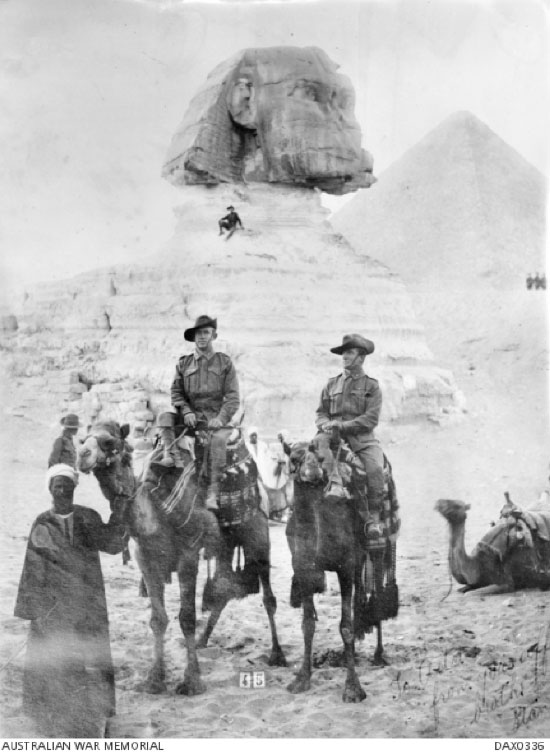
‘To Ada from your aff[ectionate] brother Stan’ is written at bottom right in this fine photograph taken at the Sphinx in Egypt in April 1915. Stan Muir is sitting on the camel at left.
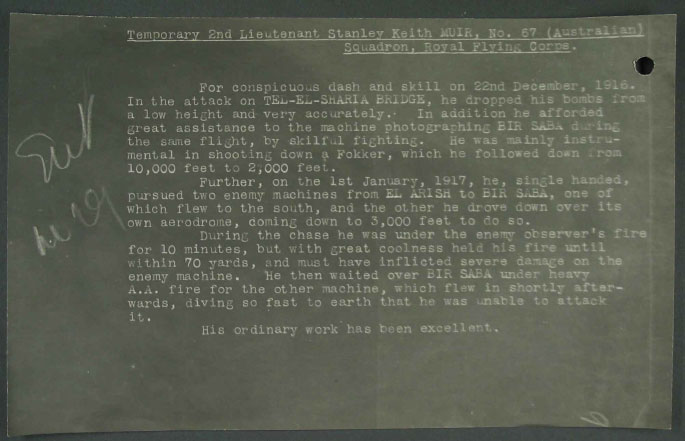
Recommendation for Stan Muir’s Military Cross
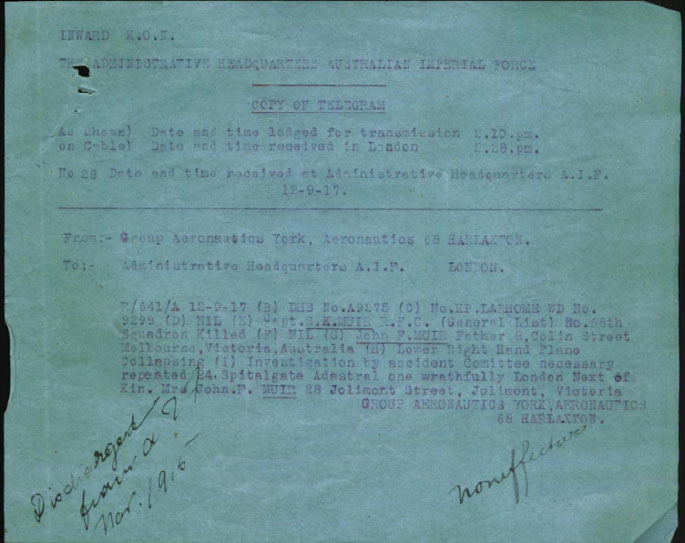
Telegram concerning Stanley Muir’s death
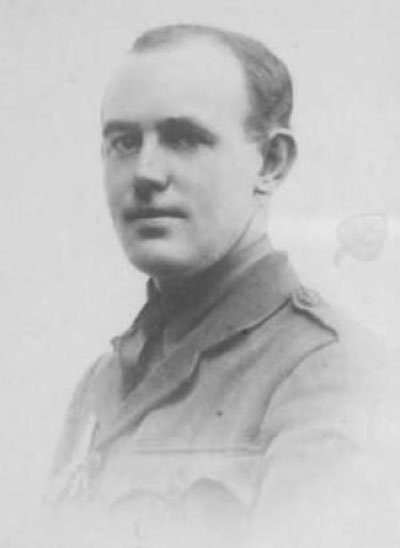
Stanley Muir was 25 at his death
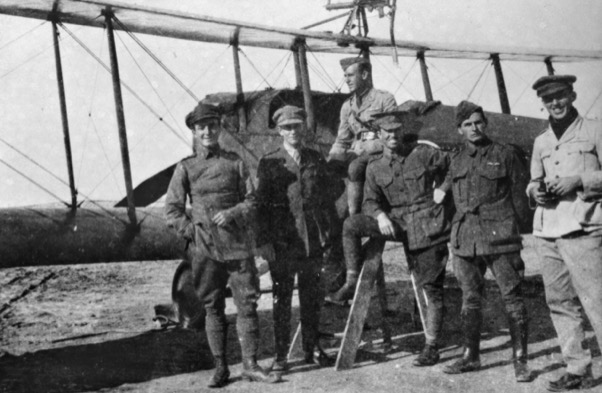
Stan Muir is at the back in the centre of this photograph of happy Australian airmen in Egypt. The aircraft is a Martinsyde, the type that he used to achieve the first AFC aerial victory of the war. The men with him include some famous Australian airmen. Frank McNamara, far left, was the only Australian airman to win the Victoria Cross in WWI. Richard ‘Dickie’ Williams, smiling at centre, was the ‘father of the RAAF’, established after the war. Lawrence Wackett, at far right, was later knighted for services to aviation, including designing aircraft and managing the Commonwealth Aircraft Corporation.
Sources:
- Australian War Memorial – Roll of Honour and Honours and Awards
- Black, Sylvia, ‘Muir, Stanley Keith’, East Melbourne Historical Society website, http://emhs.org.au/person/muir/stanley_keith
- ‘Capt Stan Muir’, Great War Forum, http://1914-1918.invisionzone.com/forums/index.php?showtopic=152734
- Commonwealth War Graves Commission website
- Mishura Scotch Database
- Molkentin, Michael, Fire in the Sky: the Australian Flying Corps in the First World War, Allen and Unwin, Sydney, 2010
- National Archives of Australia – B2455, MUIR STANLEY KEITH
- Scotch Collegian 1917
- The AIF Project - https://www.aif.adfa.edu.au/showPerson?pid=216973


